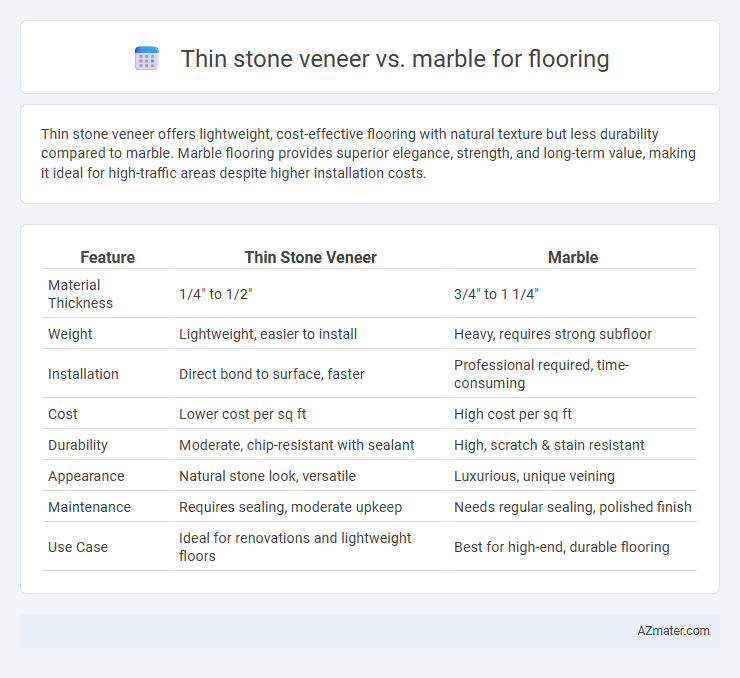Thin stone veneer offers lightweight, cost-effective flooring with natural texture but less durability compared to marble. Marble flooring provides superior elegance, strength, and long-term value, making it ideal for high-traffic areas despite higher installation costs.
Table of Comparison
| Feature | Thin Stone Veneer | Marble |
|---|---|---|
| Material Thickness | 1/4" to 1/2" | 3/4" to 1 1/4" |
| Weight | Lightweight, easier to install | Heavy, requires strong subfloor |
| Installation | Direct bond to surface, faster | Professional required, time-consuming |
| Cost | Lower cost per sq ft | High cost per sq ft |
| Durability | Moderate, chip-resistant with sealant | High, scratch & stain resistant |
| Appearance | Natural stone look, versatile | Luxurious, unique veining |
| Maintenance | Requires sealing, moderate upkeep | Needs regular sealing, polished finish |
| Use Case | Ideal for renovations and lightweight floors | Best for high-end, durable flooring |
Introduction to Thin Stone Veneer and Marble Flooring
Thin stone veneer offers a lightweight, cost-effective alternative for flooring that replicates the natural beauty of full-thickness stone with easier installation and reduced structural load. Marble flooring, known for its luxurious appearance and unique veining, provides a durable and timeless surface that enhances interior aesthetics but typically requires more maintenance and higher initial investment. Both options deliver distinctive stone looks, with thin stone veneer excelling in versatility and marble prized for its classic elegance and value.
Composition and Material Differences
Thin stone veneer is composed of natural stone slices, typically 1/2 inch thick, bonded to a backing material for lightweight, flexible application, whereas marble flooring consists of solid, dense slabs of metamorphic limestone with a thickness usually ranging from 3/4 to 1 inch. The mineral composition of marble includes calcite and dolomite, resulting in its characteristic veining and polished surface, while thin stone veneer often retains the raw texture of the parent rock, such as slate, quartzite, or sandstone. Material differences impact durability, maintenance, and installation costs, with marble offering superior hardness and a premium finish, whereas thin stone veneer provides easier handling and cost-effective decorative options.
Aesthetic Appeal and Design Versatility
Thin stone veneer offers a natural, textured look that enhances aesthetic appeal with a rustic or contemporary vibe, providing design versatility for various architectural styles. Marble flooring exudes timeless elegance with its smooth, polished surface and unique veining patterns, making it ideal for luxurious and classic interiors. Both materials allow customization in color and finish, but marble provides a more refined and sophisticated appearance, whereas thin stone veneer offers a broader range of tactile and visual effects.
Installation Process and Complexity
Thin stone veneer offers a lighter, more manageable installation process compared to marble, requiring less structural support and specialized tools. Marble flooring demands precise cutting, leveling, and sealing to ensure durability and aesthetic appeal, often necessitating professional expertise. The complexity of marble installation is higher due to its weight, fragility, and need for skilled craftsmanship to prevent cracks and uneven surfaces.
Durability and Longevity Comparison
Thin stone veneer offers high durability with resistance to cracks and chips due to its composite backing, making it suitable for high-traffic areas, while marble flooring, although elegant, is softer and more prone to scratching and etching over time. Marble requires regular sealing and careful maintenance to preserve its longevity, whereas thin stone veneer typically demands less intensive upkeep. Both materials can last decades with proper care, but thin stone veneer generally provides better resilience against wear and environmental factors in flooring applications.
Cost Analysis: Initial and Long-Term Expenses
Thin stone veneer offers a more cost-effective initial investment compared to marble flooring, with prices typically ranging from $3 to $7 per square foot, while marble can cost between $10 and $30 or more per square foot. Long-term expenses favor thin stone veneer due to its lower maintenance requirements and greater durability, reducing costs related to cleaning, sealing, and potential repairs. Marble demands regular upkeep, including polishing and sealing, which increases overall lifetime costs despite its luxurious appearance.
Maintenance Requirements and Care
Thin stone veneer requires less maintenance than marble flooring due to its durability and resistance to chipping and staining. Marble demands regular sealing and careful cleaning with pH-neutral products to prevent etching and discoloration. Both materials benefit from prompt spill cleanup, but marble's porous nature increases its sensitivity to acidic substances and heavy wear.
Environmental Impact and Sustainability
Thin stone veneer offers a significantly lower environmental footprint compared to marble flooring due to its reduced material extraction and transportation requirements. The lightweight nature of thin stone veneer decreases energy consumption during installation and reduces waste, enhancing sustainability. Marble flooring, while durable, involves intensive quarrying processes and higher carbon emissions, impacting ecosystems and increasing its overall environmental impact.
Best Applications and Suitable Spaces
Thin stone veneer offers a lightweight, cost-effective solution ideal for accent walls, fireplaces, and commercial spaces with limited structural support, providing natural texture and durability. Marble flooring, prized for its elegance and timeless beauty, suits high-end residential and hospitality interiors where luxury and polished finishes enhance aesthetic appeal. Both materials excel in areas with moderate foot traffic, but marble's porous nature requires sealing in moisture-prone spaces, while thin stone veneer is better suited to vertical applications and dry conditions.
Pros and Cons: Thin Stone Veneer vs Marble Flooring
Thin stone veneer offers a lightweight and cost-effective flooring option with easy installation and natural stone appearance, but it may lack the durability and high-end luxury feel of marble. Marble flooring provides unmatched elegance, timeless beauty, and superior durability, though it requires higher upfront costs and regular maintenance to prevent staining and scratching. Choosing between thin stone veneer and marble flooring depends on budget, desired aesthetic, and long-term maintenance preferences.

Infographic: Thin stone veneer vs Marble for Flooring
 azmater.com
azmater.com